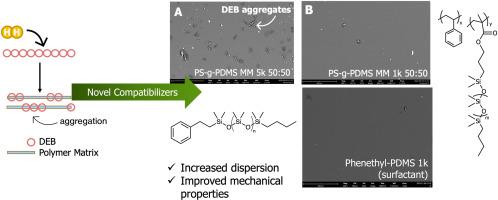Blend compatibilizers for alkyne-containing hydrogen “getters” in crosslinked siloxanes
IF 4.5
2区 化学
Q2 POLYMER SCIENCE
引用次数: 0
Abstract
Low molar mass multi-alkynes, commonly called hydrogen getters, continue to receive attention due to their ability to irreversibly sequester hydrogen gas in sensitive environments such as ultra-high vacuum and electronics. 1,4-bis(phenylethynyl)benzene (DEB) bisalkyne offers suitable reactivity as an evaporable getter due to efficient stoichiometric hydrogen uptake. However, as expected, poor dispersibility in polymer matrices and crystallization upon hydrogenation restrict DEB to powdered form factors. Compatibilizers will promote a more homogeneous dispersion throughout non-polar polymeric networks. Thus, this research employs styrenic graft copolymers to effectively disperse DEB. Free radical copolymerization of styrene with a poly(dimethyl siloxane) macromonomer (PDMS-MM) of varying molecular weights (1k and 5k) afforded effective graft copolymer compatibilizers. Furthermore, facile hydrosilylation of styrene with a hydride-terminated PDMS-MM provided an alternative phenethyl-PDMS MM 1k low molar mass compatibilizer that also effectively promoted DEB dispersion. Both high molecular weight styrenic graft copolymers and low molecular weight siloxane compatibilizers were suitable to disperse alkyne-containing hydrogen scavengers in siloxane networks.


交联硅氧烷中含炔氢“吸收剂”的共混增容剂
低摩尔质量多炔通常被称为吸氢剂,由于其在超高真空和电子设备等敏感环境中不可逆地吸收氢气的能力,一直受到人们的关注。1,4-双(苯乙基)苯(DEB)双炔由于其有效的化学计量氢吸收率而提供了合适的反应性。然而,正如预期的那样,聚合物基质中的分散性差和氢化后的结晶限制了DEB的粉末状因素。增容剂将促进非极性聚合物网络中更均匀的分散。因此,本研究采用苯乙烯接枝共聚物来有效分散DEB。苯乙烯与不同分子量(1k和5k)的聚(二甲基硅氧烷)大单体(PDMS-MM)的自由基共聚提供了有效的接枝共聚物相容剂。此外,苯乙烯与末端氢化物的PDMS-MM的硅氢化反应提供了一种替代的苯基- pdms mm1k低摩尔质量相容剂,也有效地促进了DEB的分散。高分子量苯乙烯接枝共聚物和低分子量硅氧烷相容剂都适合分散硅氧烷网络中的含炔氢清除剂。
本文章由计算机程序翻译,如有差异,请以英文原文为准。
求助全文
约1分钟内获得全文
求助全文
来源期刊

Polymer
化学-高分子科学
CiteScore
7.90
自引率
8.70%
发文量
959
审稿时长
32 days
期刊介绍:
Polymer is an interdisciplinary journal dedicated to publishing innovative and significant advances in Polymer Physics, Chemistry and Technology. We welcome submissions on polymer hybrids, nanocomposites, characterisation and self-assembly. Polymer also publishes work on the technological application of polymers in energy and optoelectronics.
The main scope is covered but not limited to the following core areas:
Polymer Materials
Nanocomposites and hybrid nanomaterials
Polymer blends, films, fibres, networks and porous materials
Physical Characterization
Characterisation, modelling and simulation* of molecular and materials properties in bulk, solution, and thin films
Polymer Engineering
Advanced multiscale processing methods
Polymer Synthesis, Modification and Self-assembly
Including designer polymer architectures, mechanisms and kinetics, and supramolecular polymerization
Technological Applications
Polymers for energy generation and storage
Polymer membranes for separation technology
Polymers for opto- and microelectronics.
 求助内容:
求助内容: 应助结果提醒方式:
应助结果提醒方式:


